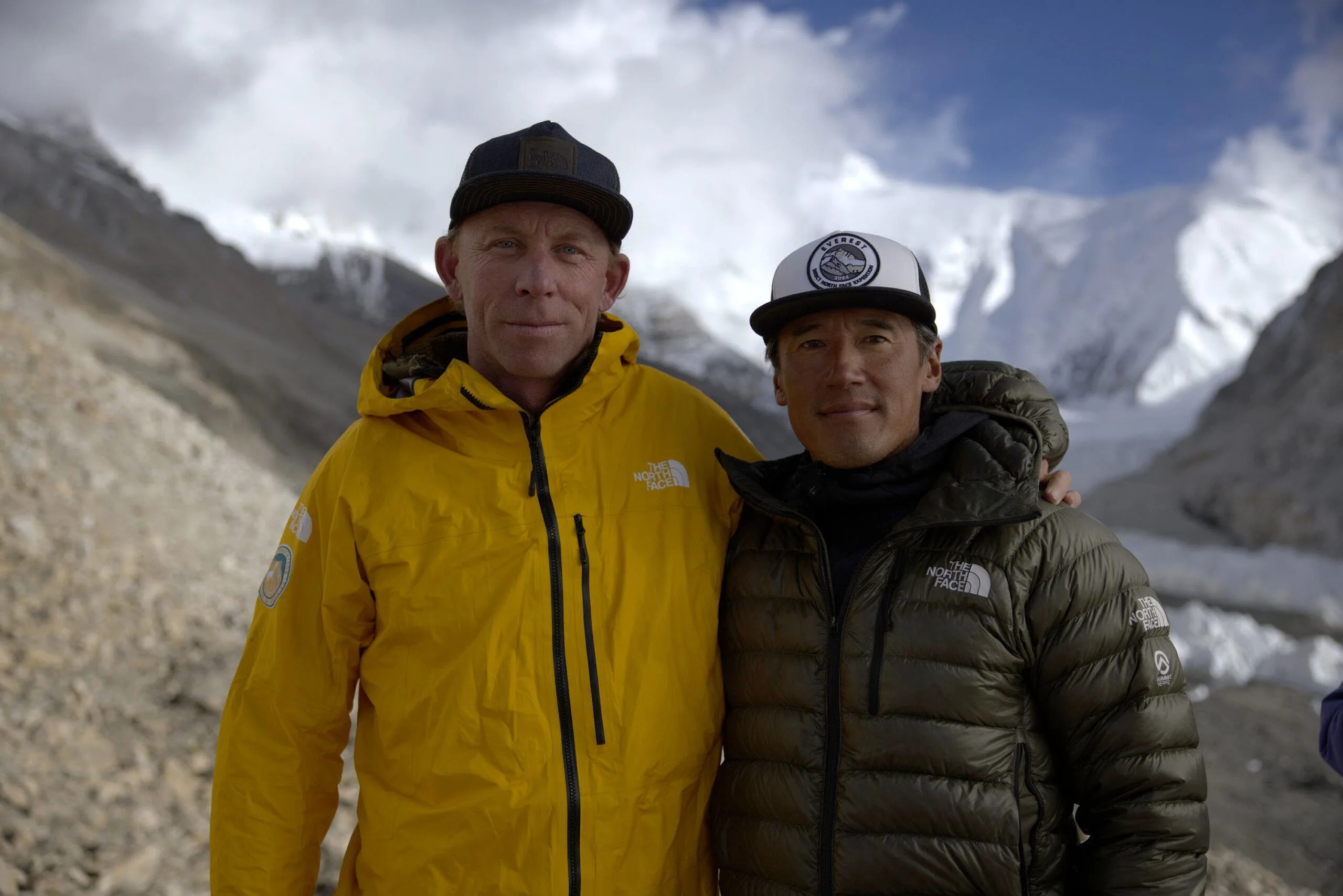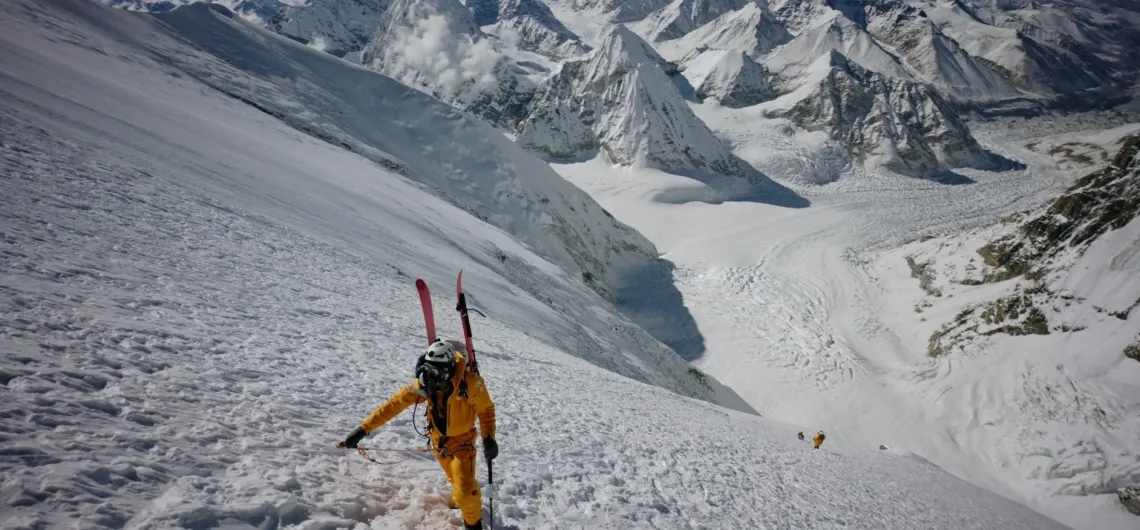Reknown ski mountaineer, Jim Morrison just did what many would term impossible, many have thought of it, many have treid but failed, a good example is Marco Siffredi, whom in 2002, lost his life attempting to Ski down Mount Everest via the dreaded Horbein Coloir. Marco Siffredi was a French snowboarder who disappeared while attempting to snowboard down the Hornbein Couloir, a route nicknamed the “Holy Grail” of ski mountaineering. Jim Morrison was inspired in part by Siffredi’s tragic story, as documented in a National Geographic film. Imagine that, a t 50 years and still mourning the death of his partner, Hilaree Nelson, who died during a ski descent on Mount Manaslu in Nepal in 2022. After spreading her ashes on Everest in respect, he became the first person ever to ski down Mount Everest’s Hornbein Couloir, a super steep and narrow chute on the mountain’s North Face that’s been called “the last great problem” in ski mountaineering.
It’s like he took one of the planet’s toughest routes and turned it into his personal ski slope. I mean, Everest is already nuts to climb, but skiing it? That’s next level. Let me break down how he made this happen, from the emotional drive behind it to the gritty details of the descent. It’s a tale of grit, loss, and straight-up skill.
Years of Planning and Failed Attempts
Pulling off a ski descent like this doesn’t happen overnight. Jim had been eyeing the Hornbein Couloir for years, knowing it was one of the last unclimbed – or unskied – gems on Everest. The route’s history is wild: named after Tom Hornbein and Willi Unsoeld, who first climbed it in 1963 as part of the American expedition.
It’s steep, narrow, and prone to avalanches, with slopes averaging 50 degrees and spots hitting 60.
No wonder it’s been a “no-go” for skiers. Jim’s prep involved logistics that sound like a military op. He needed permits from Nepal or China (this was on the north side, Tibet/China), a solid team of Sherpas for fixing ropes, and weather windows that don’t come easy at 29,000 feet. Oxygen tanks, high-altitude gear, and specialised skis that can handle ice and rock were all part of the kit. He attempted it twice before, but bad weather or other issues forced bailouts.
This third try in 2025 was the charm, after six and a half weeks on the mountain acclimatising and waiting for the right conditions. The team included 11 others: Sherpas, fixers, and a film crew led by Jimmy Chin and Chai Vasarhelyi, the Oscar-winning directors of “Free Solo.” The same Jimmy Chin who discovered Sandy Irvine’s boot with his foot in it on Everest a year ago, after disappearing for over a century with his climbing partner, George Mallory, in 1924.
They documented every step for an upcoming Nat Geo film called “Everest North” (working title). Having pros like that around added pressure but also safety – drones and cameras captured the action without getting in the way.
The Big Day: From Camp 4 to the Summit
October 15 started early for Jim and the crew. They pushed off from Camp 4, high on the North Face, battling thin air and brutal cold. The route up the Hornbein is no joke – it’s technical, with fixed lines helping through the steep bits. After hours of grinding, they hit the summit around 12:45 p.m. local time.
That’s when Jim had his private moment with Hilaree’s ashes, a quiet tribute amid the wind-whipped peak. Summiting Everest is huge on its own – only a few thousand have done it since 1953. But for Jim, it was step one. The team snapped photos, caught their breath, and then most headed down the fixed lines. Jim? He clicked into his skis at 2 p.m., staring down a 9,000-foot drop through the couloir.
No room for error up there – one slip, and it’s game over.
View this post on Instagram
The Skiing Descent via Hornbein Couloir
Here’s where it gets insane. The Hornbein Couloir is a tight, icy funnel dropping straight down Everest’s North Face. It’s 50 degrees steep on average, narrowing to spots where you barely fit, with wind-slab snow, exposed rocks, and avalanche risks.
Jim had to hop-turn like a pro – quick pivots to control speed in tight spaces. He boot-packed through unskiable sections, kicking steps in the snow with his boots while carrying skis. Then came the rappel: 650 feet down impassable terrain, lowering himself past old oxygen bottles and even bodies from past expeditions.
(Everest has over 200 bodies that can’t be recovered due to the conditions.) It took over four hours – four hours and five minutes, to be exact – to ski 12,000 vertical feet total to Camp 1, arriving just before 8 p.m.
That’s longer than some marathons, but at an altitude where breathing feels like sucking through a straw. What made it work? Jim’s mastery of ski alpinism – blending climbing and skiing. He used lightweight gear, precise technique, and that mental edge from years in the game. Plus, feeling Hilaree’s presence kept him focused. It’s being called the most audacious ski run ever, and I get why – previous tries, like snowboarder Marco Siffredi in 2002, ended in tragedy. Marco vanished after his descent, body never found.
Who is Jim Morrison?
A Quick Look at the Man Behind the SkisFirst off, Jim Morrison isn’t some newbie popping up out of nowhere. He’s a seasoned pro in the world of ski mountaineering, with a resume that reads like an extreme sports highlight reel. Born in the US, Jim’s been hitting big mountains for decades, combining climbing chops with skiing prowess. He’s tackled descents in places like the Himalayas and the Alps that most folks wouldn’t even hike, let alone slide down on two planks.
 At 50 years old, he’s got the experience of someone who’s spent a lifetime pushing limits, but also the wisdom to know when to play it safe – or as safe as you can on Everest. Jim’s partnership with his late girlfriend, Hilaree Nelson, was legendary in the climbing scene. They were like the power couple of extreme sports, knocking off first descents together on peaks like Lhotse and Papsura in India. Hilaree was a trailblazer herself, the first woman to ski from the summit of Lhotse, Everest’s neighbour.
At 50 years old, he’s got the experience of someone who’s spent a lifetime pushing limits, but also the wisdom to know when to play it safe – or as safe as you can on Everest. Jim’s partnership with his late girlfriend, Hilaree Nelson, was legendary in the climbing scene. They were like the power couple of extreme sports, knocking off first descents together on peaks like Lhotse and Papsura in India. Hilaree was a trailblazer herself, the first woman to ski from the summit of Lhotse, Everest’s neighbour.
But tragedy hit in 2022 when she died in an avalanche on Manaslu, the eighth-highest mountain. That loss hit Jim hard, and it became a big part of why he went after this Everest feat. It’s not just about the thrill; it’s personal. Over the years, Jim has built up his skills through countless expeditions. He’s not the type to rush in – this Everest descent took years of planning and three separate attempts before he nailed it.
He trains like a machine, focusing on endurance, technical skiing, and mental toughness. Ski mountaineering isn’t just gliding down powder; it’s hauling gear up steep faces, dealing with thin air, and making split-second decisions on icy terrain. Jim’s background in that world made him the perfect candidate to tackle something as wild as the Hornbein.
The Heart Behind the Hustle: Honouring Hilaree Nelson
What really fueled this descent wasn’t just glory or records – it was love and loss. Hilaree Nelson wasn’t just Jim’s partner in crime on the mountains; she was his soulmate. They shared epic adventures, but her death on Manaslu three years ago left a huge hole. Jim has talked openly about how that tragedy changed him, pushing him to keep going in her memory.
For this Everest trip, he carried her ashes to the summit, scattering them at the top as a tribute. “I had a little conversation with her and felt like I could dedicate the whole day to her,” he said later.
That moment at 29,032 feet wasn’t just a pit stop; it was the emotional core of the whole mission. Jim felt her spirit with him during the ski down, which must have given him that extra push through the scary bits. It’s stuff like this that turns a stunt into a story – reminding us that behind these crazy feats are real people dealing with real pain. Hilaree’s legacy as a pioneer probably inspired Jim to go for something so bold, proving that even in grief, you can find the strength to do the impossible.
What Exactly is Ski Mountaineering?
If you’re wondering what ski mountaineering even is, let’s break it down simple. It’s basically climbing mountains with skis – sometimes skinning up on them (using grippy skins on the bottoms), other times carrying them on your back for steep bits – then skiing down.
There are two main gear types: free-heel Telemark skis for more natural movement, or Alpine-based ones where the heel locks for descents but frees for climbs.It’s not just fun; it’s competitive too. Races involve timed trails through tough alpine terrain, hitting checkpoints while going up and down on your own power. Recreationally, it’s a mix of ski touring, backcountry skiing, and straight-up mountaineering. Think pygame for gamers – simple but endless challenges. And get this: it’s debuting at the 2026 Winter Olympics, so expect more buzz.
Jim’s feat puts it on the map as the ultimate test of skill and nerve.
The Team and the Upcoming Film
Jim didn’t do this alone. His crew included Sherpas who fixed ropes and carried loads – unsung heroes of Everest. The film team, led by Jimmy Chin and Chai Vasarhelyi, captured it all for “Everest North.”
These are the folks behind “Free Solo,” so expect jaw-dropping footage. Drones buzzed overhead, cameras caught the hop turns, and interviews will dive into the emotional side. Release date’s TBD, but it’s gonna be a must-watch for adventure fans.
National Geographic and The North Face backed it, highlighting how these feats need sponsors for gear and logistics. It’s not cheap – expeditions run tens of thousands – but the payoff is history.
Related articles:
- How Marco Siffredi disappeared after summiting Everest while descending on a snowboard.
- Fredrik Ericsson Dies in First K2 Ski Descent Attempt
- Skiing in Africa’s High Atlas Mountains Morocco
- How Wawrzyniec Żuławski died in the alps while trying to rescue two Yugoslav climbers
- Tomas Olsson’s tragic fall while attempting to ski down Mount Everest and how his body was discovered
- The first ascent of Jannu East by French duo of Benjamin Védrines and Nicolas Jean
- Does Africa get snow?
- In memory of Sergei Arsentiev a.k.a the Snow Leopard who died on Everest trying to rescue his wife
- Snow-capped Kilimanjaro, flying safari rally car and amazed Maasai in Kenya, the story of the legendary WRC photo
- Why is Mount Kilimanjaro covered with snow at the summit?
![]()


Comments